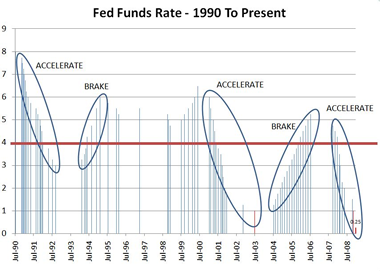Follow-up To Smaller Schools
SEARCH BLOG: EDUCATION
I received the following email regarding my earlier post about Smaller Schools [personal identification removed]:
My response was:Enjoyed reading your blog and your perspective on smaller schools. But I must respectfully disagree with your hypothesis, that smaller schools will require more money in staff and support services, larger class sizes and that school buildings will have to be abandoned.First, please go to www.essentialschools.org and see how they organize a school.
Second, for integration of technology into education as a means to increase learning and change the paradigm of teacher as knowledge source go to www.edutopia.org.
As a requirement for smaller schools, 400 or fewer students, funds shall go directly to the building, not to the district. Site management is also required joining authority and responsibility at the work site -- a successful business model that represents one of the keys to the success of a very large organization, Toyota, and a smaller one, Patagonia (and W. L. Gore before it was sold). Site management also creates the opportunity for innovation in education that District bureaucracies and political committees unintentionally kill.
To improve the chances for smaller school success, and encourage the effective utilization of very expensive capital resources, schools should be run year round (we are no longer a farm based society), classes should be available from 8:00 AM until 10:00 PM and teachers allowed to collaborate on the development and delivery of curriculum to achieve a learning goal, not successful content regurgitation (The outcome of NCLB and the AYP compliance).
The new Parker High School in Howell, Michigan is attempting to incorporate some of these innovations. They have a brief PowerPoint presentation on the web that explains them in more detail. This experiment may fail since it depends upon local support and a bureaucracy to survive, and must comply with the pseudo scientific accountability of standardized testing.
Finally, take a small journey into a long ago and far away educational model that was abandoned due to World Wars, economic depression and the tyranny of Fredrick Taylor's misunderstood and myopically applied "Scientific Management"; read a little book, "Totto Chan: The Little Girl at the Window" that, in a humorous and delightful way, describes the educational philosophies of Dewey and Pestalozzi.
I appreciate your communication regarding this subject and understand that there may be benefits for at-risk children from smaller schools with less students per teacher.If you, dear reader, choose to go to www.edutopia.org you will see some interesting examples of new educational approaches. I agree that they appear promising.
My points were that:Certainly, students can benefit from more individual attention if class sizes are reduced. So will individual tutoring benefit them. That can be achieve now without the added expense of 100 new schools. Simply hire more teachers.
- unless you kept the student-teacher ratio the same, you would increase costs
- your administrative staff costs would be higher because you are replicating many times what you do once at a larger school
- the facilities would not be comparable in many ways [physical education/sports/libraries] or would be very costly to make them comparable
- the talent/knowledge pool among the teachers would be narrower than those found at larger schools with a greater number of teachers
- the curriculum itself is unchanged which is a separate and important issue, but may be more limited with a smaller teaching staff
- the plan does not adequately address the issue of what happens to the existing facilities as students are removed... more schools mothballed with continuing expense to the districts? [students for proposed new schools have to come from somewhere]
This effort does not address the overall content of education. I agree that it can address discipline problems and possibly reduce dropout rates. But the arguments that smaller schools are qualitatively and experientially better than larger schools for all students simply does not resonate with my knowledge of larger suburban schools.
But compare those shining examples to what you see at large inner city schools and ask if the transition to schools of 400 students or less can be made without the enormous costs I outlined above... far more than simply new facilities. Detroit or Saginaw or Benton Harbor schools are a planet away from educational utopia. org.The principles of smaller schools, smaller student-teacher ratios, creative use of technology, and practical application of learned subjects can be applied to existing facilities and dedicating the resources toward more teachers, technology, and creative curricula through a university model... while retaining the advantages of more extensive shared facilities.
I would argue that an existing model for high school facilities should be something similar to Lake Orion, Michigan as opposed to a middle school of 400 students. While I believe 1,000 to 1,200 students are more likely to achieve a sense of school "spirit", this high school demonstrates that even larger schools offer much more to the students and community than schools of 400 could possibly achieve... especially with regard to the facilities and the variety of curriculum options... options that realistically address the variety of interests that students have as opposed to trying to interest all students with a limited curriculum and losing many.
| Lake Orion High School 495 E. Scripps Road Lake Orion, Michigan 48360 248-693-5420 Todd Dunckley, Principal | The Lake Orion High School is a student-centered facility housing 2200+ students in grades 9-12. Opened in 1997, it has the latest in technology and includes a state-of-the-art auditorium, field house, and natatorium for student and community use. Lake Orion High School was selected as a Michigan Blue Ribbon School and is recognized as a 1999-2000 Blue Ribbon Exemplary School by the U.S. Department of Education. Lake Orion High School offers a broad-based curriculum with numerous options for all students. Specifically in technology, classrooms offer courses for the in-depth study of communication, lasers, robotics, construction, manufacturing, power and energy, and other developing technologies. |
..








































